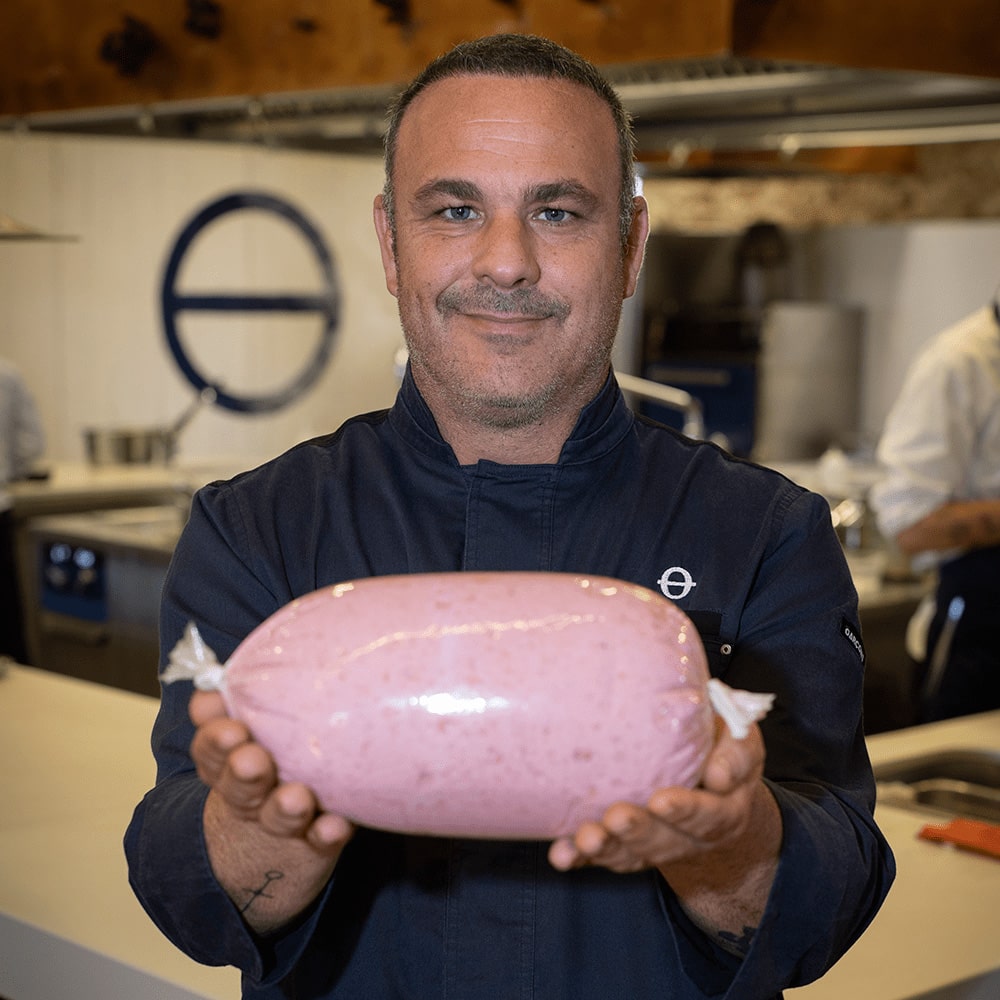
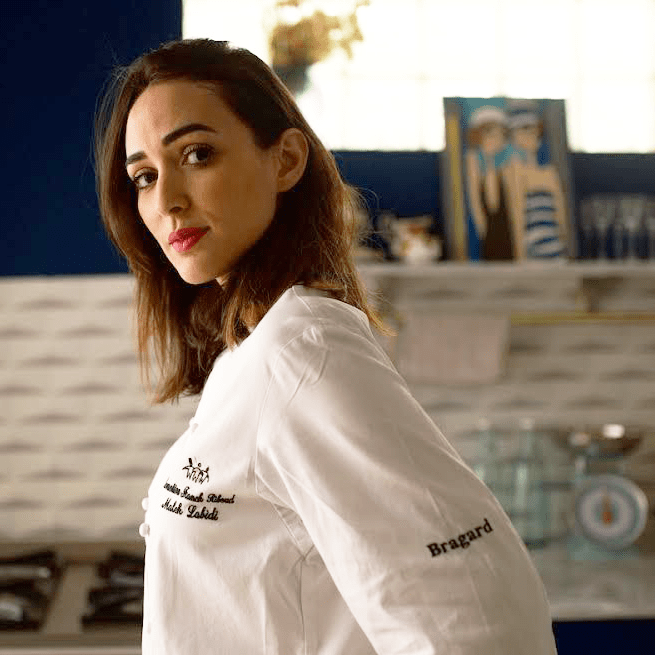
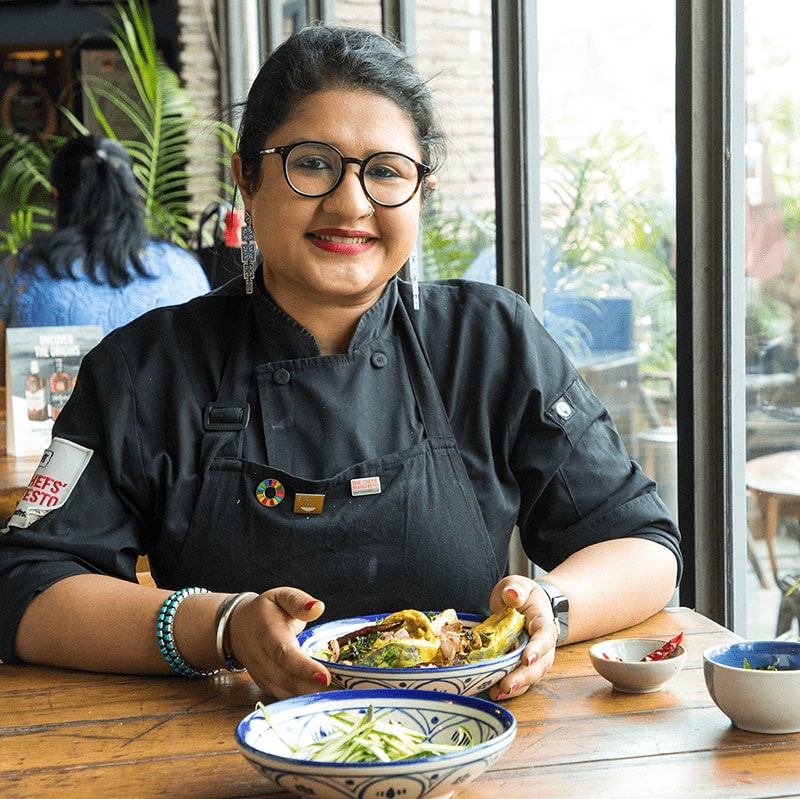
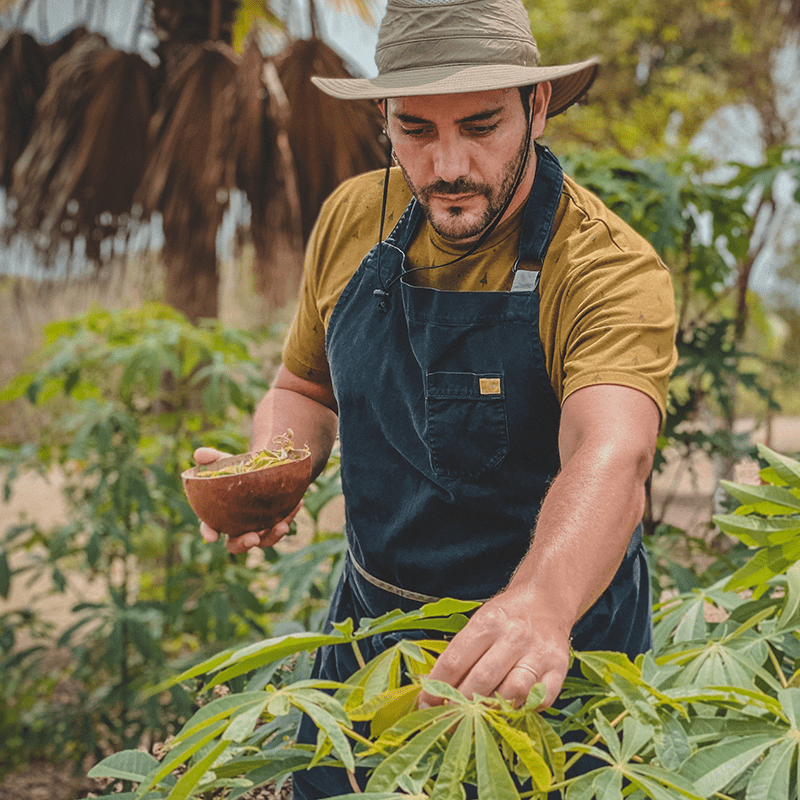
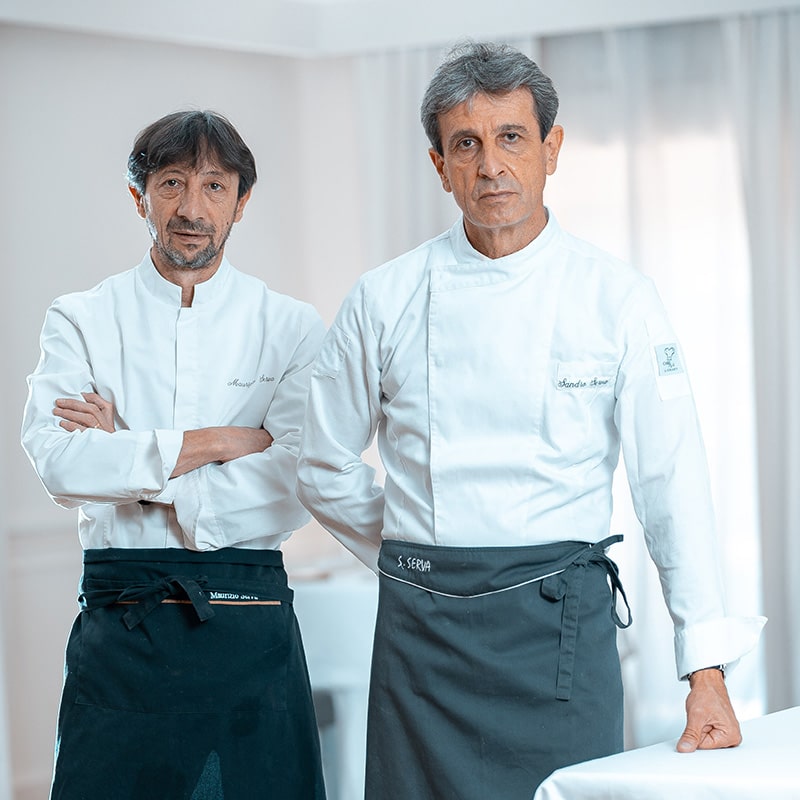
Rivodutri, Italy
ÁNGEL LEÓN Angel León is Spain’s Chef del Mar, the “Sea Chef” celebrated for fashioning wonders out of the Mediterranean’s humblest, most overlooked produce: here are sardines as you’ve never had them before, and plankton as you’ve never had it… well, ever. This frugality-themed inventiveness has earned León three Michelin stars and the Green Star for Aponiente, his restaurant at El Puerto de Santa María close to Cádiz, and a further star for his newer venture nearby, Alevante. Both menus evince a half-rigorous, half-playful quest for a form of marine autarky – a longing to substitute the sea for the land in all things, or almost. Why use butter to thicken a sauce, when you can use fish eyes? Why mess about with egg white to clarify a consommé, when micro-algae will do? And why, while we’re at it, throw out anything at all? If the sea made it, then you can eat it.
For our book, León has chosen a recipe that is both a feat of lateral thinking and simplicity incarnate. He has looked to mortadella, the Italian heat-cured luncheon meat sausage known to Americans as baloney, and recreated it with morralla. This is “no-name” fish – bycatch consisting of flathead grey mullet and suchlike, generally discarded or used at best for stock or surimi crab sticks. At the opposite (but equally fish-minded) end of Europe, Norwegians speak of ufisk, literally “un-fish”. Ufisk is fish too cheap or ugly to serve in its own right, the kind of stuff you might even get for free – if the fishmonger can be bothered to stock it.
León, by contrast, rescues the fillets from the bycatch and grinds them up, then adds mortadella spices – typically a finely crushed mixture of salt, white pepper, garlic powder and pistachio nuts – which he works thoroughly into the ground fish flesh. (The pistachios can be left chunkier, or even whole.) For the next step, León stuffs this matter into a synthetic skin – in effect, a narrow transparent plastic bag – to obtain a fat cylinder which he seals shut at both ends.

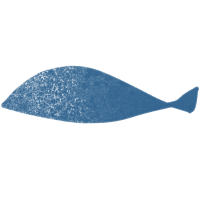

The “sausage” is then placed in a hot water bath (or steam bath) on the hob, at exactly 82 degrees Celsius for two hours. When the time’s up, León plunges his creation straight into an ice-filled bowl. As the protein cools, the fish sausage acquires a mortadella-like texture and cut.
Slice your fish mortadella thin and have it on crusty white bread.
MALEK LABIDI For Malek Labidi, landing an economics degree in Paris was a concession to expectations, an academic baseline from which to follow her true path: that of professional kitchens. Having come up through the Institut Paul Bocuse (a period she describes as a gruelling but exhilarating three years), she cut her teeth with Alain Ducasse at the Plaza Athénée hotel in Paris before returning home to Tunis to open Le Bô M. That restaurant broke new ground by offering a daily changing menu, in a conservative market hooked on tried-and-tested fixtures. Several years on, Labidi has acquired a national following through catering State occasions and fronting TV cookery programmes. An advocate of fresh produce and healthy diets, she updates her homeland’s versatile cuisine – looking both out, across the Mediterranean, and inland, towards sun-soaked gardens and orchards.
Labidi has cooked for us a whole seabass immersed in a salt crust. The fish should be gutted, but the scales must stay on. Half the pleasure of eating seabass is its moist mouthfeel, almost a flavour in itself: the salt seals in this moisture while seasoning the fish through its skin. The sauce vierge, which involves dressing tomatoes and herbs in lukewarm olive oil, coats the seabass like a scented balm.
As well as a whole fish, Labidi uses a large quantity of coarse sea salt – four kilograms or so. She also uses an orange for zest; a lemon for both zest and juice; a red onion; long green peppers; a large bunch of fresh dill, stems included; dry thyme; a sprig of rosemary; fresh ginger; juniper berries; and olive oil.
First, Labidi pre-heats the oven to 200 degrees Celsius. Meanwhile, in a large deep bowl, she mixes the salt with some chopped dill, thyme, juniper berries that she crushes lightly, and grated ginger and lemon zest. (If this is too much to mix in one go, do so in batches; also, keep some dill for later.) Labidi then lays a thick layer of aromatic salt in the bottom of an oven tray, places the fish on top, and covers it completely with the rest of the mixed salt. The tray goes in the hot oven for 20 minutes.
To make the sauce vierge, Labidi warms olive oil gently in a saucepan for three or four minutes and takes if off the flame. Into this saucepan she cuts pieces of orange and lemon zest (pith removed), a couple of slices of ginger and the sprig of rosemary, and leaves these to infuse the oil. The onion, tomatoes and green peppers are chopped finely and placed in a separate bowl. She squeezes some lemon juice over the vegetables, seasons them with with salt and pepper, and strains the oil over them.
The seabass now comes out of the oven. Labidi cracks and removes most of the salt crust, then peels away and discards the salt-encrusted skin. The pale, glistening flesh emerges: she collects it and plates it up. Over it, she drapes the sauce vierge, with its fresh palette of reds and greens.
MEGHA KOHLI Megha Kohli’s dedication to food is no late conversion. Aged four, she recalls riding on her father’s shoulders through the spice markets of Old Delhi. At six, she was making cakes in her grandmother’s kitchen. A quarter of a century later, she admittedly cooks in a more gown-up manner, but with that early buoyancy intact. Kohli has now transferred to Café Mez and The Wine Company in the upscale Delhi suburb of Gurgaon. But her reputation was established at the more central Lavaash by Saby. At that Armenian-Indian eatery, she turned culinary heads by (among other things) baking coconut prawns inside blossoming onions. Her many online followers seem to lap up Kohli’s style: intimate yet crowd-pleasing, and – as seen here in her refusal to peel her mangoes and her doubling down on the fruit’s skins – infused with a witty millennial touch.
Kohli uses mango three-ways in this dish: powdered (amchur); slices cooked from raw, skin-on; and extra raw peels for what she calls an “additional punch”. The recipe calls for green mangoes: you don’t want a sweet wet mess. The skins are powerfully nutritious, full of fibre and antioxidants. Wash them well or go organic to minimize the presence of pesticides.
For the fish, Kohli uses boal (Wallago attu), a variety of catfish, which she marinates in advance with lemon juice, salt and turmeric. Any other freshwater fish that doesn’t flake excessively will do just as well. The lemon and turmeric help remove any whiff of geosmin, the organic compound that tends to accumulate in freshwater fish. Kohli recommends a “darne” cut, that is, thick crosscut pieces sliced through the bone. The recipe also calls for curry leaves; black mustard and cumin seeds; more turmeric; coconut milk; dried red chillies; several garlic cloves, crushed; and chilli powder. The cooking is done in ghee, the clarified butter almost universally used for frying in India. (Alternatively, you can use a neutral cooking oil with a high burning point – preferably not olive oil or butter, which are too intensely flavoured and tend to smoke heavily.)



Kohli pours ghee into a non-stick pan and adds the mustard and cumin seeds over a medium flame. When the seeds start to sizzle and pop, she puts in the sliced raw mango, the extra mango skins and the powdered ingredients – amchur, turmeric and chilli. She softens the mango for a couple of minutes, then tips in the coconut milk and cooks the sauce gently for another minute. The pieces of fish go in next, to simmer until done. (Depending on their thickness, this could take five to seven minutes or so.) Taste the sauce, season with salt as desired, and adjust the consistency with a little water or fish stock if needed.
The final step is the tempering, or tadka – the process whereby spices are blasted to the next level of taste by flash-frying them in hot fat. Kohli heats a little more ghee until it starts to smoke: she throws in the curry leaves, the crushed cloves of garlic, more mustard seeds and the dried whole chillies. She sautés the lot for half a minute and drizzles it on the fish and sauce. The curry is served over steamed rice.
RODRIGO PACHECO With its seaside location, Bocavaldivia might suggest a beach outpost of some temple of fine dining from Quito or Guayaquil. It is, in fact, one of a kind – the gastronomic wing of a comprehensive site-specific project. Here, Chef Rodrigo Pacheco and his team have regenerated a stretch of vacant land into an “edible forest” – a microcosmic food system of biodiverse farming and agro-ecological practices. In his wall-less kitchen, Pacheco marries Indigenous ingredients to seafood of fine character. Ostentation is off the menu: the edibles are near-abstract swirls of colour against unglazed black clay. But behind the spare aesthetic and short supply chain lurks great complexity of process. This is a coastal and urbane re-reading of Amazonian cuisine: local food as global discourse and sustainability template.
For our recipe, Pacheco sources prawns fresh from one of the fishing crews in nearby Puerto Cayo – several large, visually appealing crustaceans, plus a couple of smaller ones for flavour; homegrown cassava – both the fresh root and fermented flesh, as well as the leaves; neapia, a dark, spicy and smoky condiment in the form of a dense jam made with cassava starch, from which the soup takes its name; the natural, mildly peppery orange pigment achiote (also called annatto) – Pacheco grinds this into a marinade, still textured from the berries of the plant, and seasons it with salt and lime juice; garlic; chives; and finally culantro – the long-leafed, punchier cousin of coriander, which many Ecuadoreans know as chillangua and natives of the Caribbean as chadon beni.
The cassava root is peeled and grated to obtain a fistful of wet fibre, which is squeezed hard. The whitish, semi-translucent juice is collected into a bowl; the remaining dry fibre is set aside. Also into the bowl go the culantro, cassava leaves and chives; the chopped-up smaller prawns; half a teaspoon of neapia; and a small clove of garlic, lightly smashed – all of which will infuse the cassava juice.
Pacheco then peels and deveins the larger prawns, leaving the heads and tails on, and brushes them with the achiote marinade. Next, he turns to the dry cassava fibre, left after squeezing out the juice, and sifts it through a colander into a layer of coarse flour: he bakes this into a slice of crispy Indigenous bread (casabe). Separately, the dollop of fermented cassava flesh is cooked to make a diminutive tortilla. The prawns, turned a rich red from the achiote marinade, go under the grill.
Pacheco now assembles the dish. In a deep earthenware plate, he places the tortilla. Over it, he ladles the strained infused cassava broth, fragrant with herbal and marine notes. The grilled prawns are then lowered in to rest on their tails. More cassava leaves are added as vertical green accents. The final element is the casabe crisp: balanced over the stack, it signals the dish’s Indigenous inspiration.
SANDRO SERVA
MAURIZIO SERVA The phrase “family restaurant” in Italy will likely conjure a pleasant but predictably folksy experience. Nine times out of ten, the reality will be just that. At La Trota dal ‘63, the reality is anything but that. The sixty-year-old venue sits in a hamlet among wooded hills and crystal lakes. Here, brothers Sandro and Maurizio Serva and their respective sons, Michele and Amedeo, serve up food of inordinate audacity. La Trota offers nothing but freshwater fish – the only European restaurant at this level of excellence to do so. Sandro and Maurizio work the kitchen: self-taught, they have elevated what was a pit-stop trattoria to a two-Michelin star establishment. Michele and Amedeo are front-of-house: they contribute their wine knowledge and design nous. The fish served here hails from around the corner; the experience belongs somewhere altogether less homely.
Maurizio Serva cooks for us a new entry on this year’s menu. (If you fancy a go, start prepping a couple of days in advance.) The treatment preserves the toothsomeness of eel flesh while offsetting its fatty intensity. As well as the fish, Serva uses its backbone; a bunch of watercress, whose presence attests to the purity of local waters; fresh dandelion; sugar; orange, lemon and lime; a kiwi; and spices.
Serva whizzes the cress in a blender with ice water to create a grassy, peppery juice. In this juice, he places a portion of eel, which he leaves to marinate in the fridge for 48 hours. The backbone of the fish he cleans completely and dries out in the oven at 80 degrees Celsius for at least 12 hours. When the bone is dry, he fries it in very hot oil, allows it to cool and blends it into a powder. (This powder, he explains, will convey the quintessence of the eel’s flavour.)



Next, Serva simulates a dandelion “honey”. In a small saucepan, he makes a syrup with water and brown sugar, to which he adds cinnamon, star anise and a clove, together with grated lemon, lime and orange zest. With the syrup off the flame, he puts in a handful of dandelion flowers and leaves, adds a good squeeze of lemon juice and leaves the thick liquid to infuse overnight. The next morning, he strains it: the dandelion honey is ready.
Serva now turns to the kiwi. He heats up a skillet, trims the fruit, cuts it in half lengthwise and sautés it. He then sprinkles the cooked half of the kiwi with brown sugar and caramelizes it with a blow torch, before tackling the portion of eel. This he oven-roasts over bay leaves, then glazes it with the dandelion honey and blitzes it under the grill.
It’s time to plate up. The eel and kiwi (cut side down) are arranged side by side. Over them goes a dusting of the fish bone powder. Next to the plate, in a refreshing herbal counterpoint, Serva places a cold glass of the filtered cress marinade.




